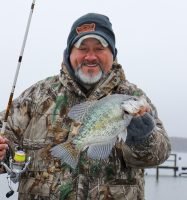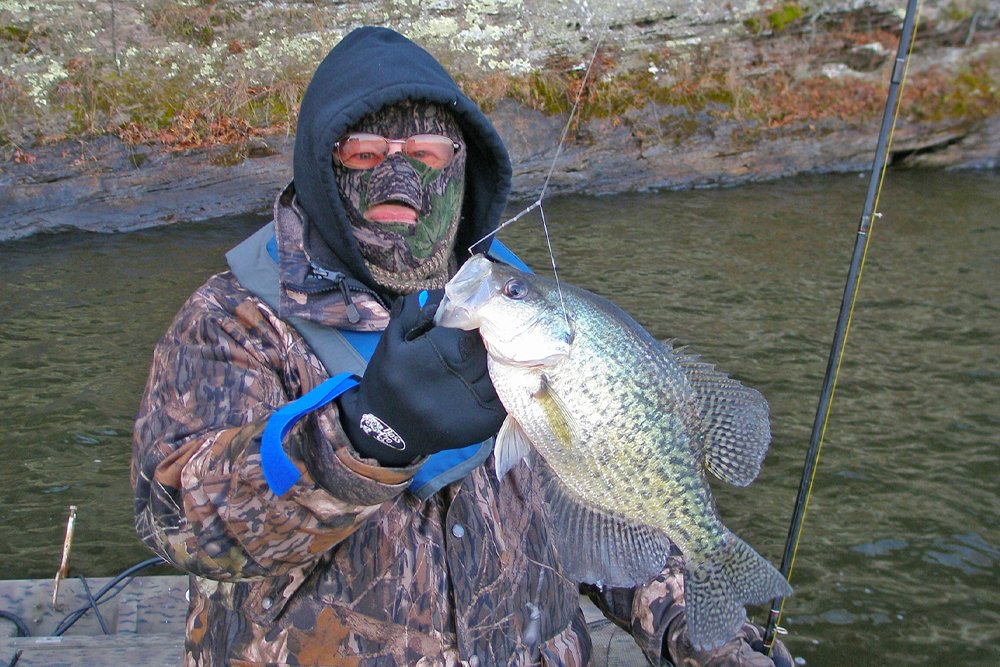Author Tim Huffman used a bottom-bouncing rig to catch his deepest crappie ever at 58 feet.
The frigid waters pushed fish into the deep rocks at a bluff. You can catch fish all year long if
you can find their location and use the right tactics. (Photo: Tim Huffman)
Finding Crappie 365 Days a Year
by Tim Huffman
Tournaments prove that even the best fishermen can have trouble solving the puzzle of finding and catching crappie. However, using solid rules of thumb and paying attention to key factors can increase chances of finding fish and having a successful day anytime of the year.
SEASONAL MOVEMENTS
Kevin McCarley is a tournament fisherman and part-time guide in Alabama. Sponsors include B’n’M Poles, Eye Hole Jigs, and Charlie Brewer Sliders. He agrees that finding fish can seem easy one day and almost impossible the next.
“The most important thing for any fisherman to learn is the seasonal movements of crappie,” said McCarley. “Those movements are a guide to where to start looking for fish. For example, it’s winter, so in general, crappie will be in deeper, stable water. That’s their comfort zone and where you’ll likely find them. What complicates matters are movements within the season, like a couple of warm, sunny days in the winter. Crappie will slide up in three to four feet deep flats and feed on shad. But as soon as water starts to cool, they’ll go right back down.
Pre-Spawn

“As waters start to warm in late winter and early spring, pre-spawn fish will move into the mouths of creeks. The fish are moving in to stage, which means they are getting ready to spawn when the temperatures get right. They want to be in a safe area but where it’s easy to get into the shallow spawning spots. I’ll be looking for cover at the right depth during pre-spawn and spawn.”
Post-Spawn
McCarley says fish go back out to medium depth waters after spawning. It’s a tough time because fish are so scattered. He says a weekend fisherman would be wise to longline jigs because the technique covers a lot of water to help find fish.
Summer
“In the summer the best advice I can give to any fisherman is go toward the dam in deeper water,” said McCarley. “I’ve found that to be true everywhere I’ve fished. Crappie will likely be in deep flats next to a channel. On my home lake, they’ll be on flats 20 to 30 feet deep.
Fall
“Fall is one of my favorite times. Fish move back toward the backs of creeks where they actively feed. We’ve learned that crappie move a lot more than we once believed. They move seasonally, but they will also move daily, especially in the fall when bait is moving around. After fall, crappie move back toward deeper water patterns of winter.”
STRUCTURE & COVER
McCarley says a fisherman can always find fish on the edge of a channel 365 days a year. That’s their number one preferred structure. The trick is to search a channel edge in the correct depth of water for the season.
Cover can vary depending upon whether a lake is a stained flatland lake, crystal-clear deep lake, or something in between. Cover might be grass, rocks, wood or something else.
McCarley knows that not every fisherman has or wants modern electronics.
“A technique that has worked for decades is dabbing a minnow around wood cover. You can use a cane pole or a sensitive B’n’M Pole. Look for standing timber along a channel, a visible stump field or a laydown along a deeper bank. For fishermen with basic sonar, pay attention to depths and submerged timber, too.”

For those willing to fork over the money, he says forward-facing sonar is the latest-and-greatest tool for finding crappie 365 days a year. Nothing else is as efficient at finding and pinpointing fish, along with showing a crappie’s response to a bait. It works at any depth and any season.
CATCHING FISH
Pre-spawn and spawning fish are normally active, good biters. They will attack a minnow or jig. However, springtime brings strong fronts with a lot of barometric changes that cause periods of tough fishing. After the spawn, fish will bite but catching is tougher because fish are scattered. Try longline trolling using a variety of jigs.
“Summer fish are so lethargic,” says McCarley, “they just don’t want to eat. I believe they are stressed from the warm water temperatures. Small hair jigs have worked well for me. My best summer tip is to go toward the dam to deeper water. For example, a big flat in 20 to 30 feet is the place to start on my home lake.
“In the fall I see a very aggressive bite. Fish are chasing shad in the backs of creeks, so they are in a feeding mood. Whatever your technique, keep moving until you find the fish.
“Winter fish can be somewhat active, especially if they move up on a flat during a few days of warm weather and sunshine. Have a technique to target deep fish and a technique for when fish move shallow.”
FINAL NOTE
“One more thing,” says McCarley. “A person’s experience on a lake is important. I grew up deer hunting and I believe in patterns. Deer will follow general paths and movements. So do crappie, like using a channel for travel. For many years I kept a detailed journal of where I caught fish each season, and it has helped me tremendously year after year. But with today’s mapping, it’s easy to do much of that with waypoints.”
You can contact Kevin McCarley at: 256-431-8917.
Senior CrappieNOW writer and Fresh Water Fishing Hall of Fame member, Tim Huffman, has several books, including Papermouth, Modern Fishing Techniques, available in Kindle or paperback at Amazon, or link from his website, www.monstercrappie.com


